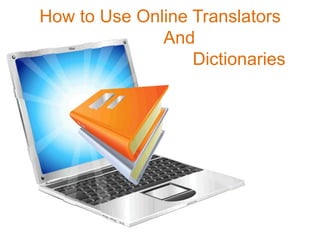
Translators
- 1. How to Use Online Translators And Dictionaries
- 2. Often, language students are tempted to use an electronic translator for “help” with assignments and homework, and then the students are surprised when their teacher immediately know what they have done. The truth is that there are several shortcomings when it comes to electronic forms of translation, and as it turns out, electronic dictionaries work a lot better than translators. hdcgfcgf How did she know I used a translator? It looked good to me! In this lesson, we are going to take a look at the following things: 1. How online translators work. 2. The shortcomings of translators.
- 3. In order to understand why online translators don’t work well, you first need to have an understanding of how they work. Most popular internet translators work based on one of two ways. 1. Rule-based translation 2. Statistical machine translation First, let’s take a look at how rule-based translators work.
- 4. Translators that are rule-based have been given a dictionary and a set of grammar rules that define the language. Then when someone inputs texts to be translated, the computer uses the dictionary it has been given, and the set of rules for grammar that it has been given, to give you a rough translation of what you input to be translated. The problem with this is, how many words have more than one meaning depending on context? How many times are there exceptions for grammar rules? Obviously, there are a lot of limitations to this method of electronic translation. Most of the time, this form of translation is going to give you a nonsensical, garbled, mess of a translation with the most literal translation possible. I read online a story about the early days of Google Translate, when they were using rule based translation. Google’s founder received an email from a fan in Korean. Obviously, he couldn’t read the email, so he put it into Google Translate. He got the translation, “The sliced raw fish shoes it wishes. Google green onion thing!”. I somehow doubt this is the message the author of the email wished to send!
- 5. The other way for computers to do electronic translation is through a method called statistical machine translation. The way that this method works is by compiling huge databases of official human translations. This method gives the computer programs translations from places like the United Nations and uses those to make translations. This is what Google Translate uses now. On the surface, it is better and is getting better all the time. But it is still not fool proof. You will notice that this method still relies on HUMANS to be doing the translation. The other issue with this method is that it requires enormous amounts of disk space to house the databases of translations, and it requires enormous amounts of computing power. This is why Google is leading the way in this type of translation, they are pretty much the only ones with the resources to do this.
- 6. Translator Shortcomings So, why shouldn’t you use a translator? Aside from the things mentioned in the previous pages about the unreliability of translators, here are a few other reasons. 1. Your teacher will know. We often type things into translators at the advanced level of text that we speak with in our own language. They give us back an advanced level of text in the target language. Often using vocabulary and verb tenses that your teacher knows that you do not know.
- 7. Translator Shortcomings 2. We use slang. How often are we even aware of when we use slang in our everyday speech? Especially with young people, slang is such a common thing that you usually don’t even realize you are using it. How can our use of slang affect the use of a translator? Well, let’s look at an example. In this case, Google didn’t even recognize the word, so it just leaves it un-translated.
- 8. Translator Shortcomings 3. We use idioms. Idioms are phrases or expressions that we use in common speech and writing that cannot be taken literally. The words or phrases have a meaning other than what you would find if you looked it up in the dictionary. Here are some examples: • Break a leg. • See eye to eye • The last straw • On the ball • Lend a hand • Piece of cake Translators do not look at the context of a sentence, but rather the meaning of the words. If you think this assignment is a piece of cake, you know that does not mean that there is a piece of cake waiting for you at the end. You know that means it is easy. The words have a different meaning than the sentence.
- 9. In the end . . . In the end, there is no replacement for the human brain. Translators can be useful for checking your work or giving you the general idea of a text. You have to keep in mind that it is a computer and it only knows what it has been programmed to know. It cannot use common sense and reasoning. It cannot look at context and make adjustments. But you can. Trust yourself and make mistakes. That’s how you learn language.